
Photo Essay: An Historic Return to the Milwaukee River and Indigenous Roots
May 5, 2021 | Topics: Events, Spotlight, Stories
By Eddee Daniel and Mark Denning
Sunrise Ceremony
The day begins in the faint light before dawn with a small group gathered in a circle around sacred fire whipped up by a gusty wind. The only sounds are a soft squawking of seagulls gathered in a flock nearby and the rattle of rigging on sailboats moored in McKinley Marina. We hold tobacco in our left hands as Mark Denning begins; he recognizes the life-giving sun, the ground beneath our feet, Lake Michigan and all water, blood of the earth; he names animals, plants, the maple tree arching over our heads, sheltering us; he invokes the elders, ancestors, our families and all who are gathered together in peace. We give thanks.
Around the circle, each in turn speaks from the heart, giving thanks for the many personal and public blessings present in our lives. For myself, I am overwhelmed with gratitude for being welcomed by this community, in this place, on this auspicious morning. Out of respect, my camera hangs limply around my neck, an inappropriate accessory in the circumstances. I will myself to let go, my accustomed impulse to shoot everything in sight freely suspended. Instead, I take my turn casting tobacco into the flames. Tobacco, we are told, is like a telephone to the Creator. Its smoke is followed by that of a sprig of cedar, to balance tobacco’s male presence with a female one and as a reminder to protect all life on earth.
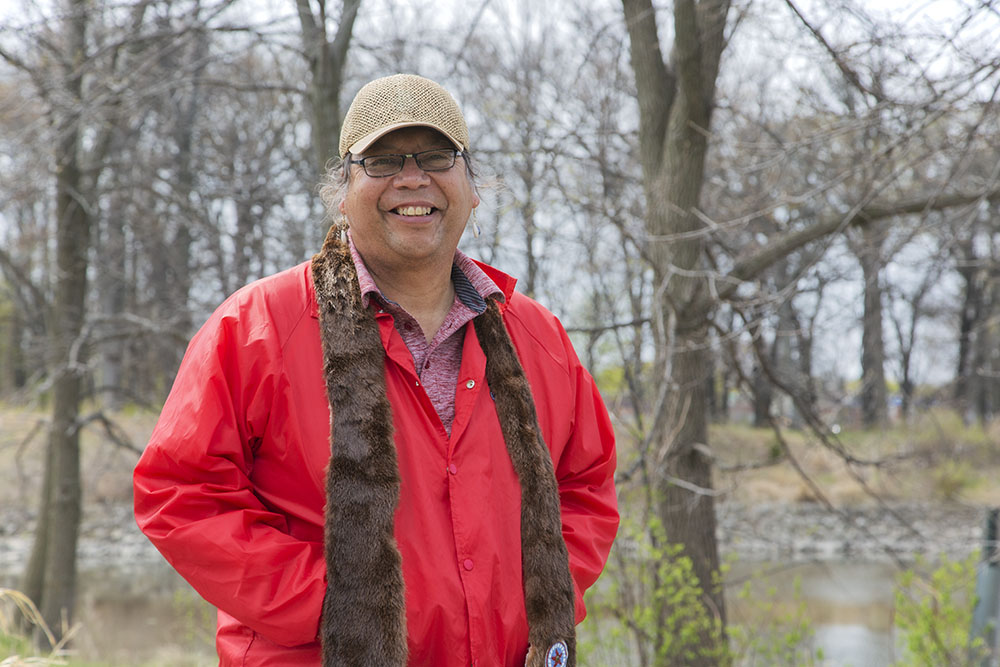
This particular site on Milwaukee’s lakefront was chosen for its historic resonance: In 1971, in solidarity with similar actions taken around the country to raise awareness and reclaim land that had been forcibly taken, members of the American Indian Movement occupied an abandoned Coast Guard station. Although the occupation lasted only a few days, the Milwaukee action was exceptional because it opened the way for the building to be converted into the Indian Community School, which operated for many years. The elegant park pavilion standing near our ceremony was styled to recall the historic structure.
We have turned out to greet the day in preparation for a journey that has been a long time coming; by one measure as long as 180 years. At Mark Denning’s invitation, a delegation of Menominee Water Protectors and other tribal members have traveled over 170 miles from their reservation north of Green Bay in order to canoe down the Milwaukee River as a way of reconnecting with their ancestors, water, lands and environment. The time is right, Mark says, for more than one reason. After over a century of degradation, the river today is being revitalized: the water is cleaner, dams have been removed, riparian lands are being protected in the Greenway, and fish are returning, including the hallowed sturgeon. Similarly, after centuries of repression, marginalization, and invisibility, there is a resurgence of interest in acknowledging and asserting Native American cultures and practices related to the land and the water. As our ceremony comes to a close, the risen sun breaks through the clouds.
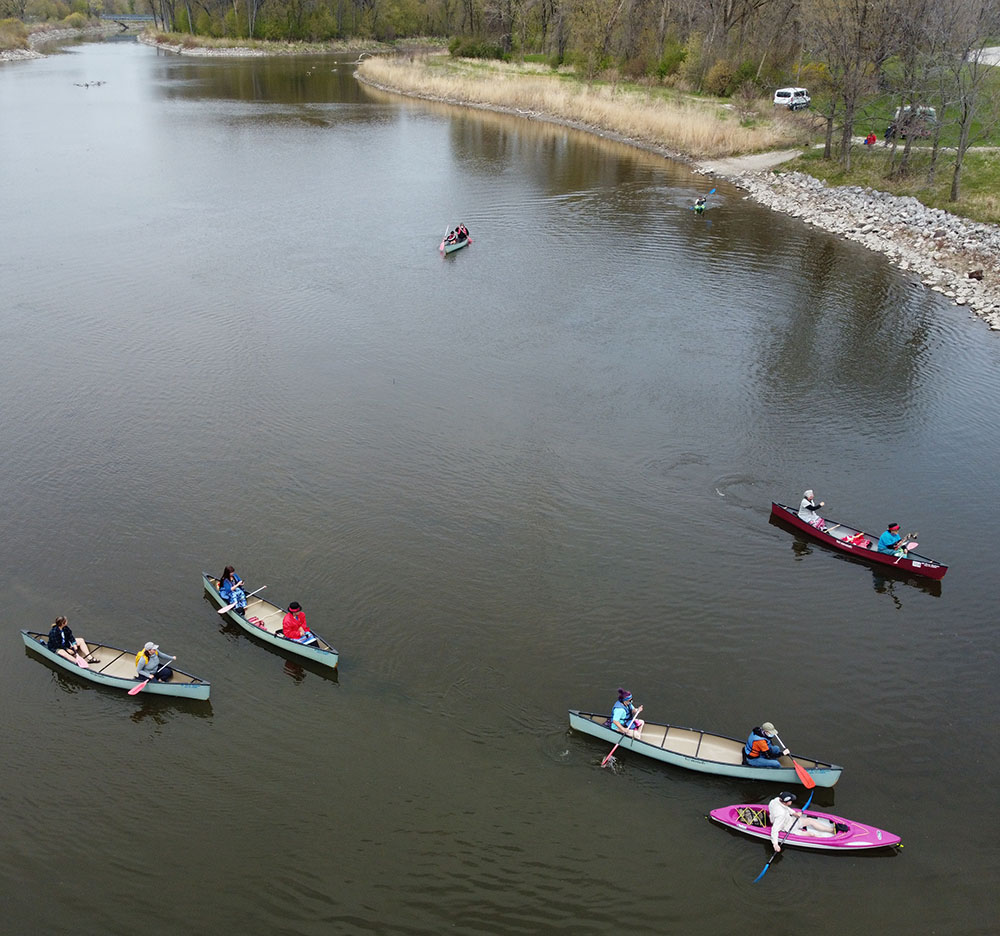
Photo credit: Steve Bell
Historical Context
By Mark Denning
Written history that relies on accounts of colonial missionaries, cartographers and explorers has the Menominee Nation rightfully centered north of Milwaukee towards Green Bay. However, thanks to trade routes that traversed the rivers and lakes, Menominee people ventured into the Milwaukee area and knew Milwaukee to be a great source of food, medicine, and raw materials. The land at the confluence of the Milwaukee, Menomonee, and Kinnickinnic Rivers was a trade hub long before the arrival of French explorers and missionaries like Pere Marquette.
When newer settlers arrived in the area, Native people were moved out by negotiation, force, guile, and outright fraud. Once comprising 100 percent of the population, by the middle of the 19th century, multiple tribes had left or been removed and replaced by settlers. The Native people who remained did so in small numbers with no officially recognized lands. We became effectively invisible to a growing and industrialized Milwaukee. Our wild rice beds were destroyed and wildlife decimated; river courses were altered, dammed, and used to convey industrial and human waste. This disruption to living people was not enough. Burial sites and mounds sacred to Indigenous people were leveled, our ancestors’ bodies built over. Despite it all, segments of different Native American populations continued to live quietly in Milwaukee.
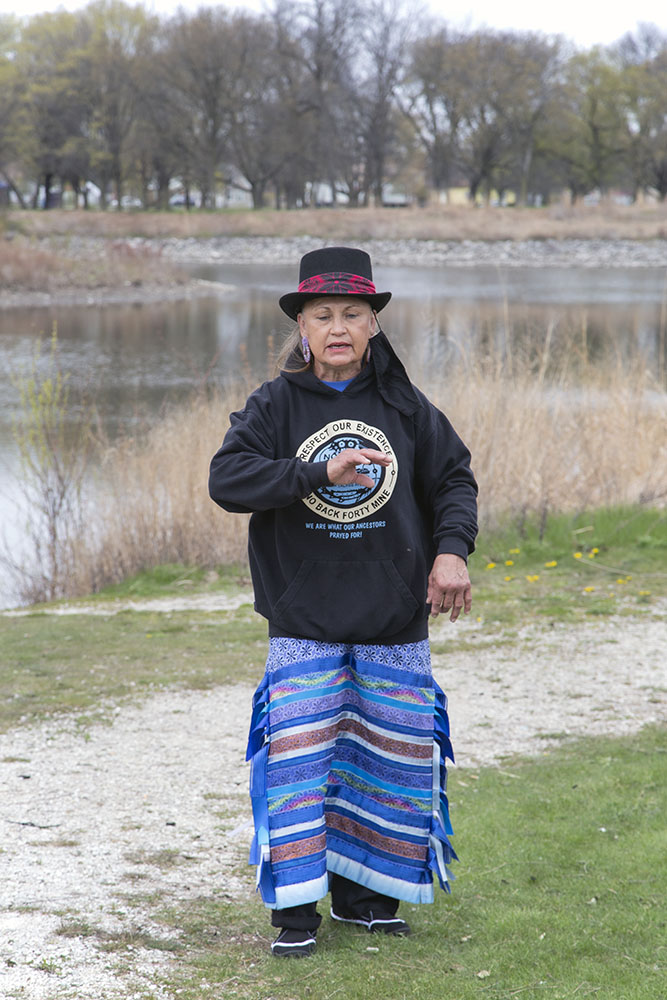
Then, with a shift away from manufacturing, the city slowly began to diversify, bringing changes for all facets of our shared community. Today, water quality has improved, wildlife habitats are being restored, and efforts to educate the community on environmental issues grows. Along with these changes has come greater awareness, targeted work towards clean energy, and healthier practices for waste management and disposal. The quality of life in Milwaukee is improving: from an industrial shroud of smog, polluted rivers unsafe to fish or swim, to a city teaming with life that once was unseen and, in many ways, forgotten.
After generations of environmental activism and work, sturgeon have returned to areas of the Milwaukee River long rendered uninhabitable for them. Dams that were made for the recreation and energy needs of Milwaukee have been removed. All of this is good news for the fish and people alike. As sturgeon have returned to the Milwaukee River, so has the presence of Native American interests and practices related to water. Today, a Menominee group named Menīkānaehkem—Community Rebuilders from the Menominee Reservation—has sponsored tribal members to canoe the Milwaukee River. (Menīkānaehkem is a grassroots community organization based on the Menominee Reservation, in Northeast Wisconsin working to revitalize our communities.)

Canoe Journey
I’ve been waiting for this moment for weeks, ever since Mark first proposed it, when we scouted the river in kayaks on a chilly day in March. The air is only marginally warmer today, and there is a steady wind, but my excitement is hard to contain. Still, I do contain my impulse to jump immediately in my kayak and head downstream. In fact, I am more excited about sharing the experience with our Menominee guests than I am in kayaking. And they are in no hurry at all!
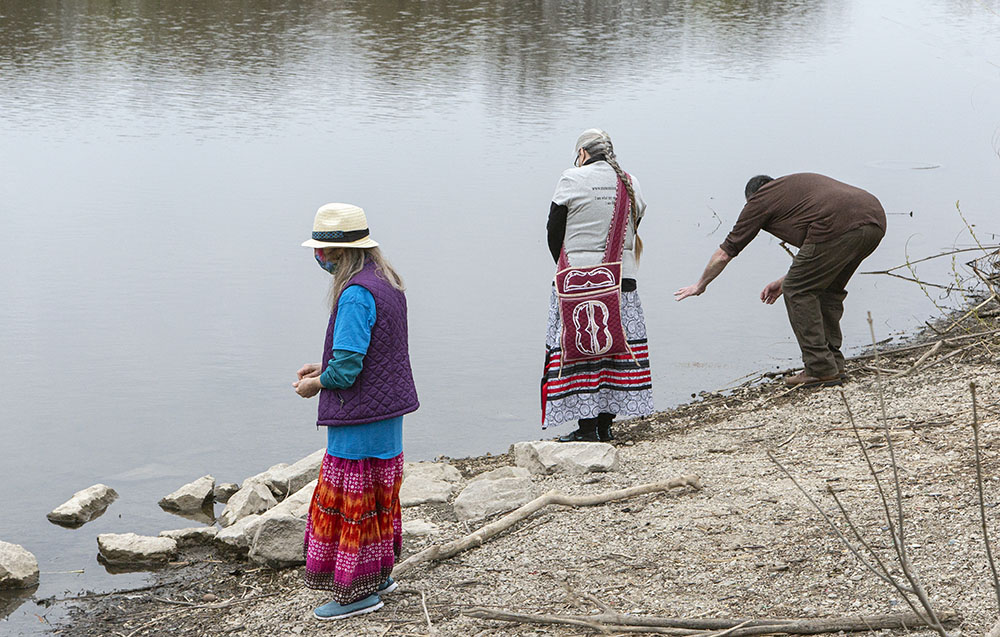
First, another ceremony: we must greet the river and honor the water. We are here not simply to paddle the river but to reestablish our connection to Water with respect and love. Taking up a pinch of tobacco in our left hands, we each solemnly proceed to the shore. With a private expression of gratitude, blessing, or reflection, we cast the tobacco on the water, watch it drift away. Before we can begin the ceremony, photographer Steve Bell is asked to call in his drone, hovering like a mechanical mosquito overhead. My camera, too, is once again held at bay. The action of taking pictures not only is distracting to this religious observance, but is also seen as a violation of the ephemeral nature of spiritual expression.
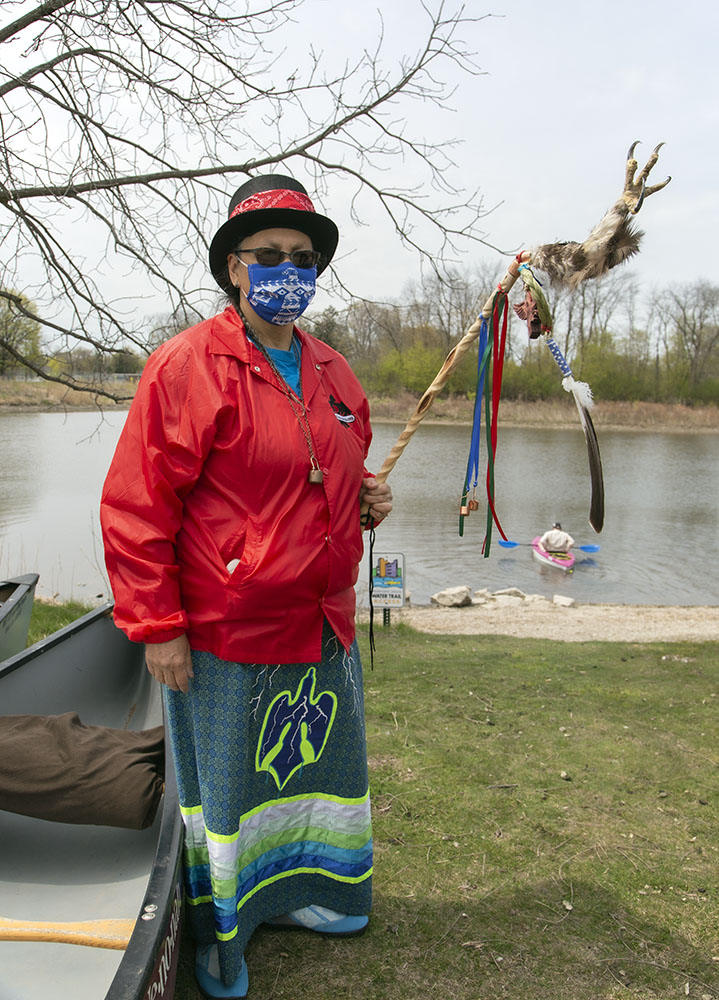
Facing east, we gather around three women in diverse stages of life who hold copper vessels of water —copper being a natural element with a symbolic connection to Water. Women lead the water ceremony not only as water bearers but also as bearers of life. We are all welcome to join in, we are told, no matter our own religious backgrounds or beliefs. Invocations are made, stories are told, and we all sip of the sacred Water. Water that remains is poured into the river, and only then are we ready to pour into our boats and embark on our journey.
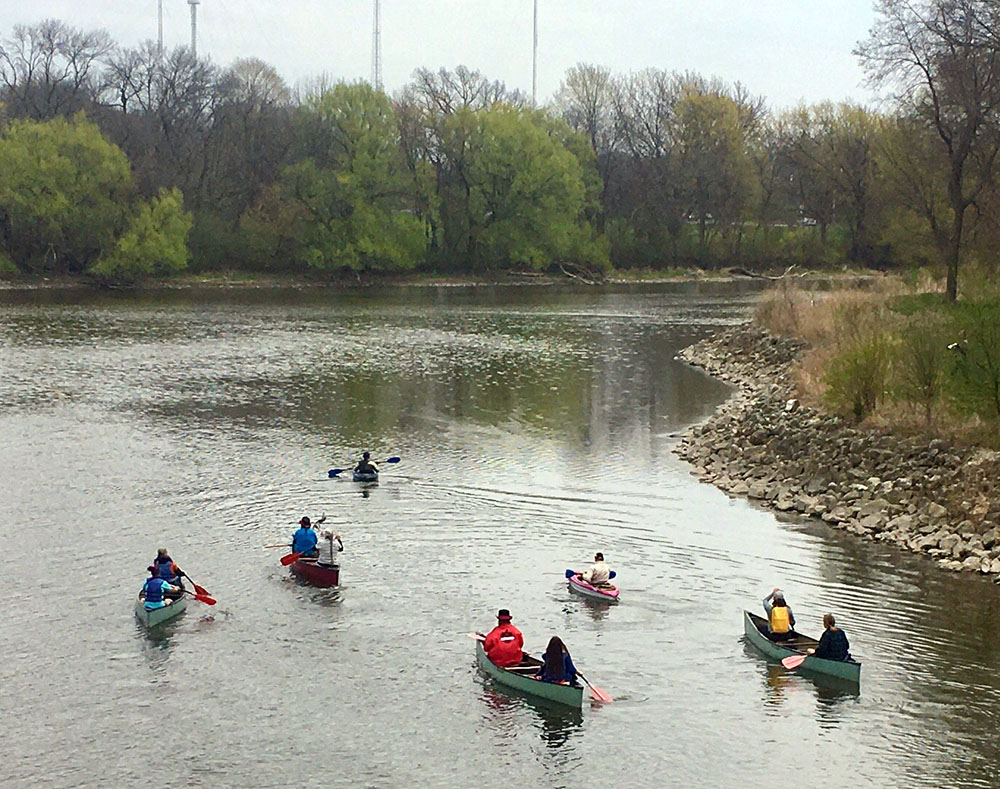
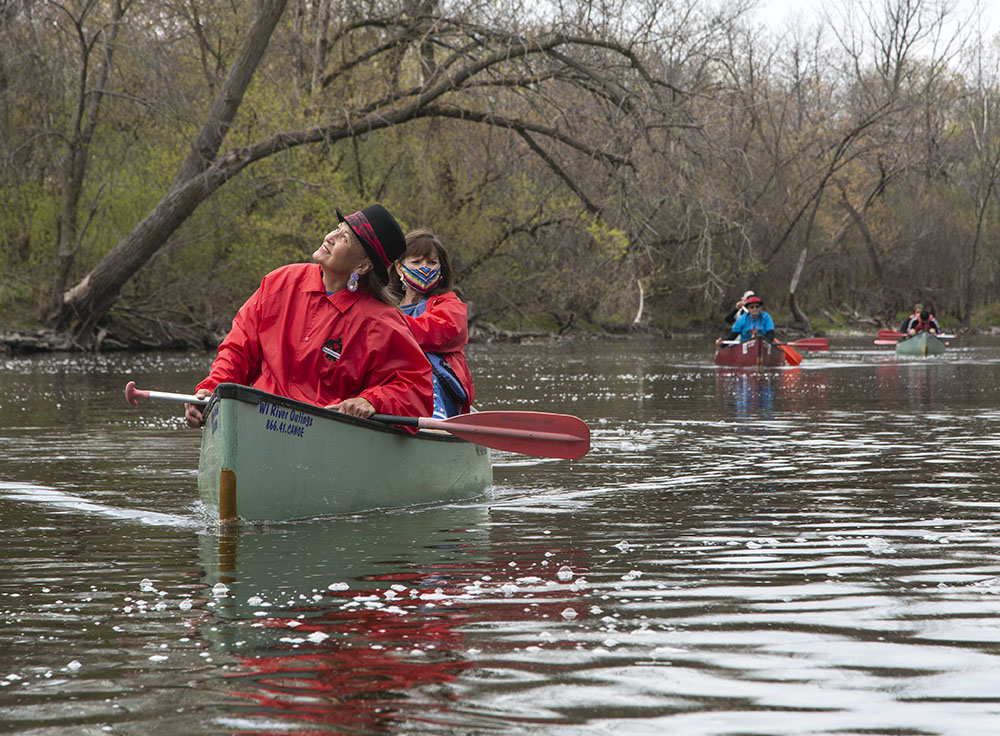
Our flock of five canoes and two kayaks pushes off from the launch on the west oxbow in Lincoln Park, picks up the current, and passes under the stone arch of the Milwaukee River Parkway bridge. We are on our way. Still checking my impulses—this time to paddle at speed—we mostly drift with the current. But now, with my camera unleashed, I observe through the lens the thrill and expressions of wonder on the faces of our Menominee guests from the north. As we pass out of sight of the last building, near where the Estabrook Dam so recently stood, and enter a narrow passage overhung with trees burgeoning with spring buds, someone whoops with joy. Several others join in. Perhaps they are calling out in empathy with the free-flowing river, perhaps simply enjoying the transition from a visibly urban environment to a surprisingly natural one. Perhaps these are intertwining notions.

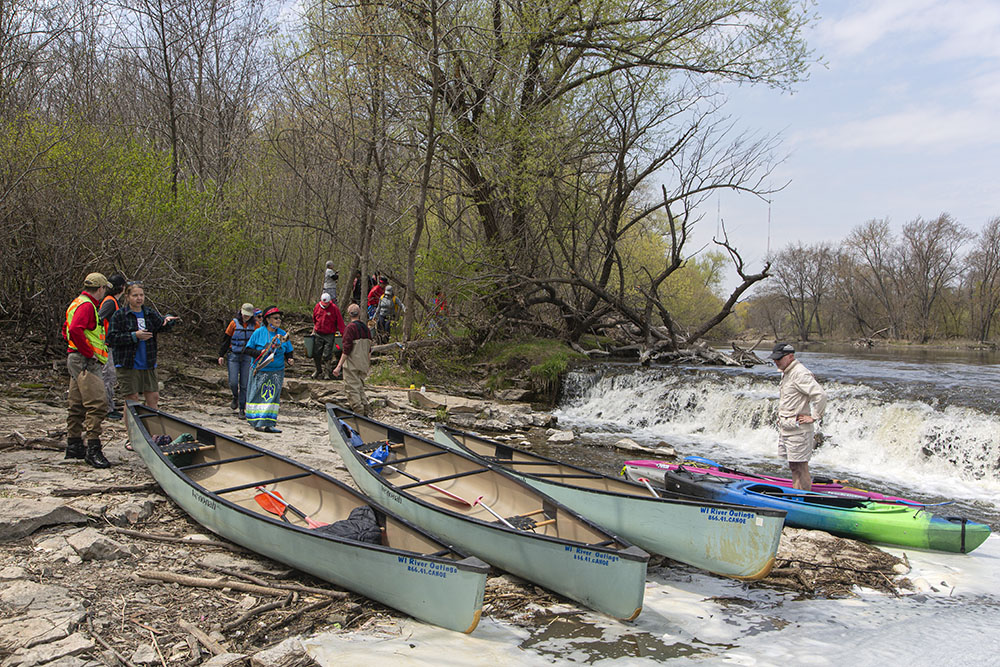
Portaging around Estabrook Falls is a chance for a side tour of the three sculptures Tom Queoff created from remnants of the dam. The sturgeon poised atop the tripod-like concrete “shark’s tooth” (a structure in the water that traps debris) is especially meaningful to the Menominee—and an opportunity for selfies!

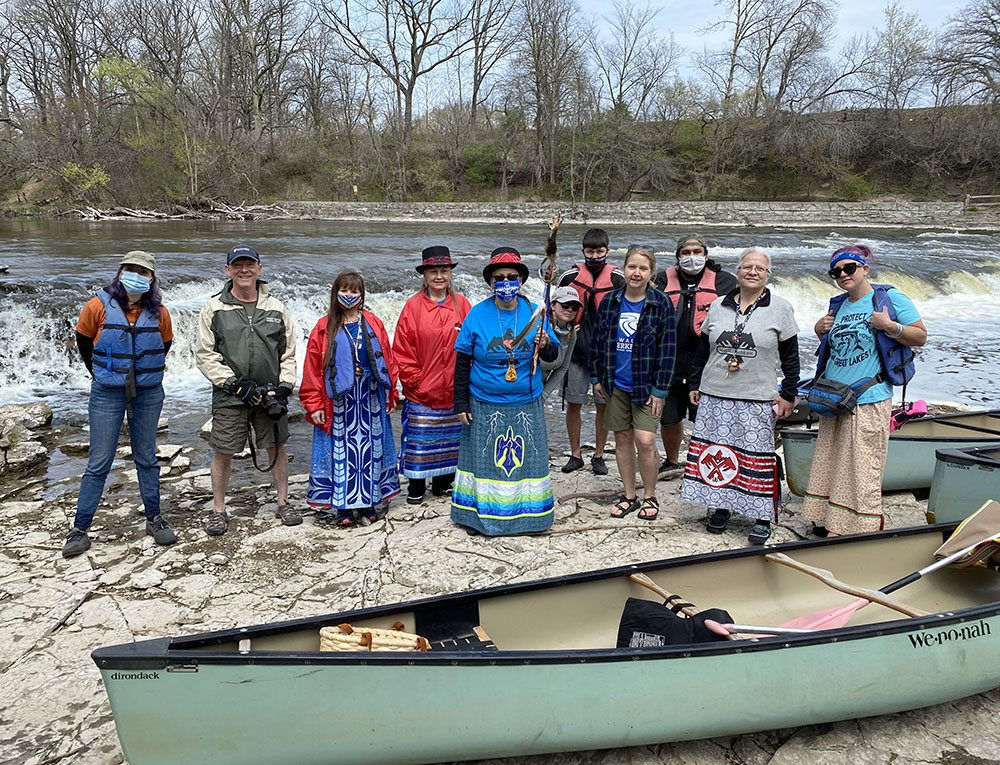

Photo credit: Danielle Kornitz
The Milwaukee River may not be as wild as some of the rivers up north, nearer to the Menominee Reservation, but it can still be a challenge, as we discover in the Estabrook Park rapids. The long, steady, rocky decline drops far enough to have inspired a short-lived mill dam in the mid-19th century. Now it presents the first thrills—and a spill—in our journey. One of our canoes hangs up on a rock, tips, and is quickly swamped. Jackets, bags, and a paddle float away to be retrieved by downstream boats. But a cell phone has been lost in the current.
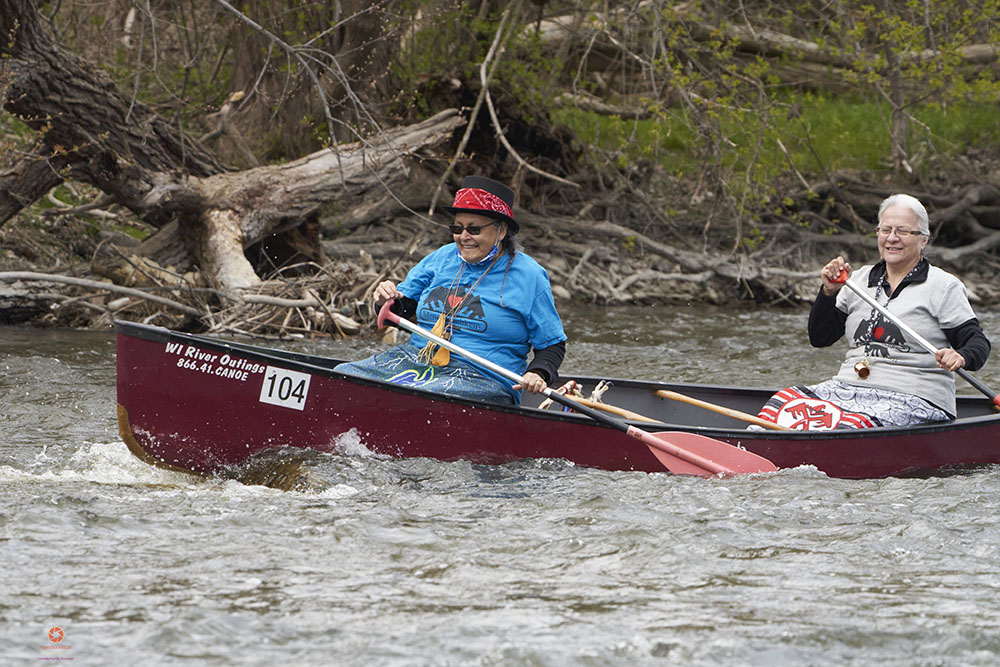
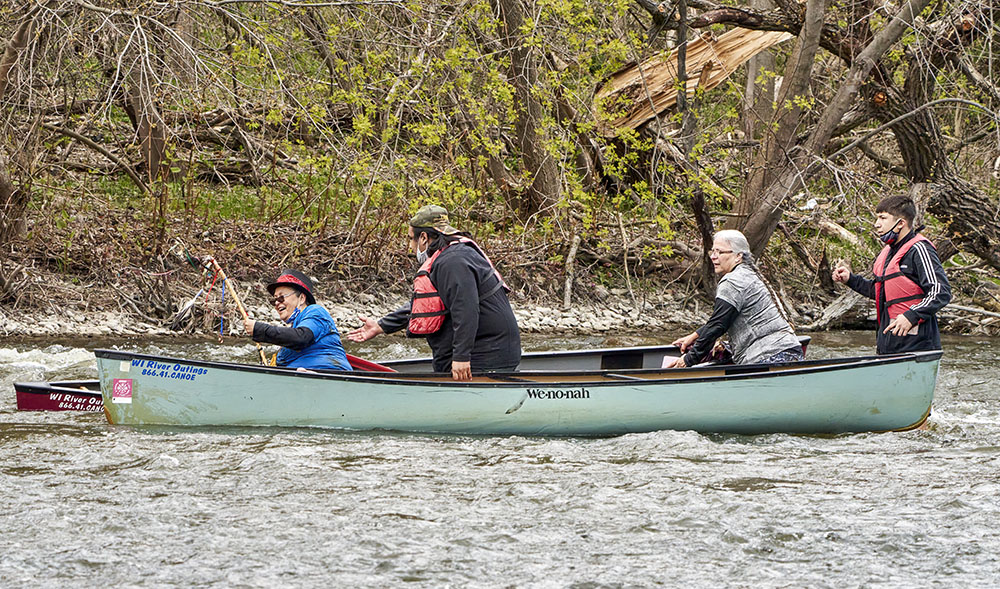

Fortunately, our lunch break is scheduled for Hubbard Park, which lies just ahead. With the canoe emptied and righted, sodden paddlers wrapped in blankets but otherwise unfazed, we scrape our way across the shallows to Hubbard, walking in the boats as we approach the shoreline. The snack lunch we had been promised turns out to be a sumptuous feast of Native American dishes and homemade whole grain breads. No one returns to our boats hungry.

The next leg of our journey, through the deepest, seemingly wildest section of the Greenway, goes by all too quickly. Paddling is optional in the strong, steady current. More whooping signals the continuing enchantment of the group. We all manage to negotiate the powerful rapids at North Avenue without further mishap. As we pull up to Kiwanis Landing at the southern end of the Greenway, my usual take-out point, I can’t help thinking that I wouldn’t mind calling it a day. But this isn’t my journey.


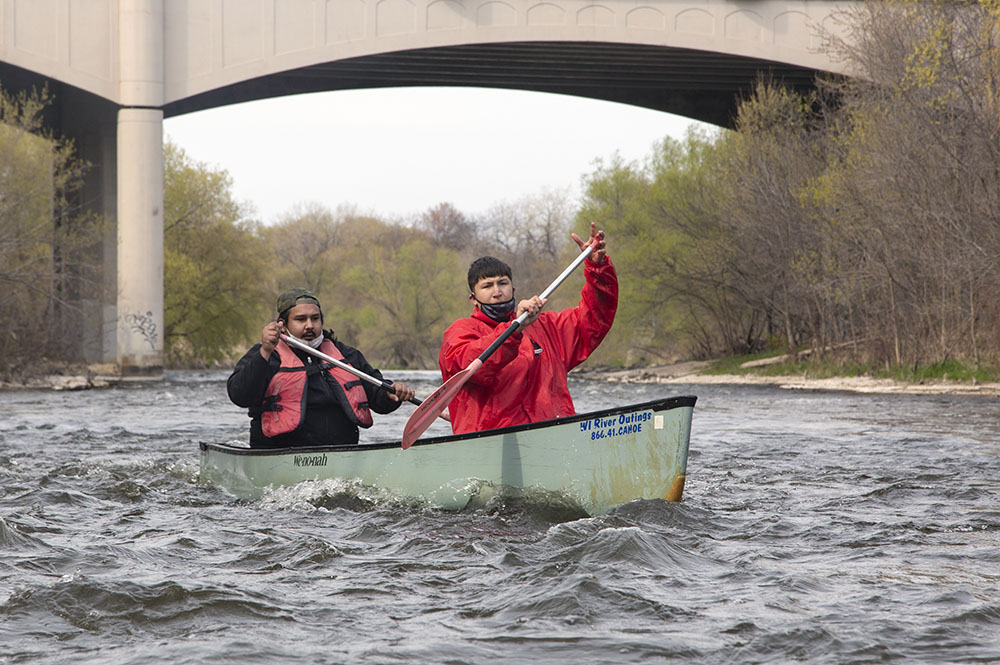
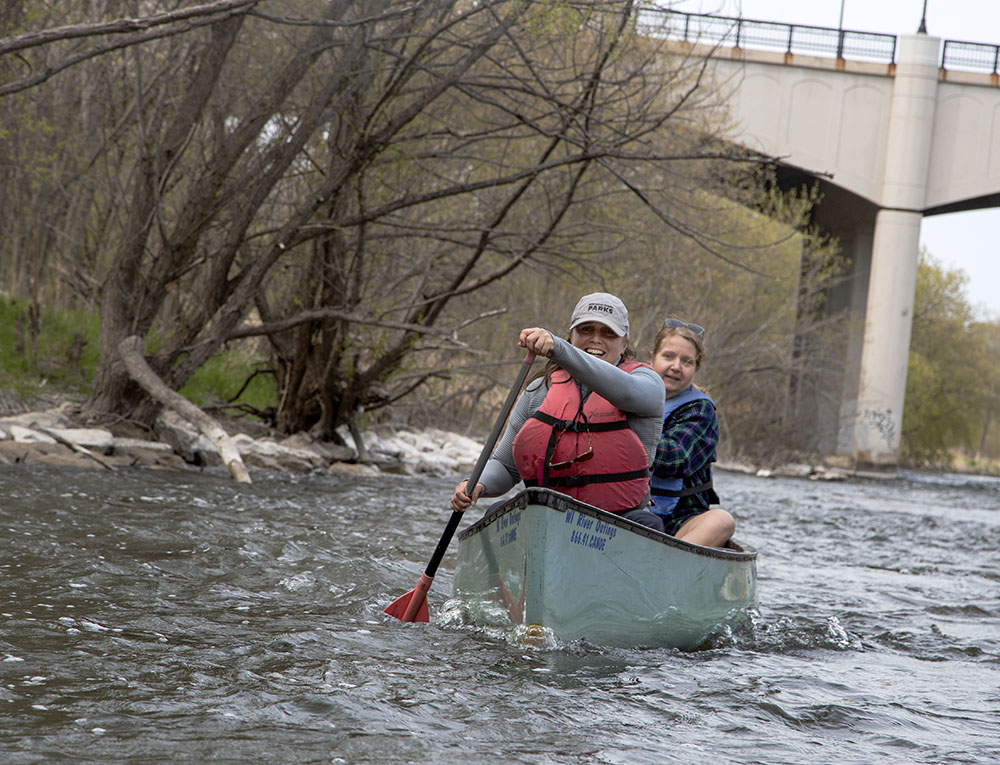
We paddle on, now on the sluggish waters of the estuary, sandwiched between the towering condos along Commerce and Water Streets, which replaced the tanneries, mills, and factories of Milwaukee’s first industrial district, in the ever-evolving history of the river. When we reach the heart of downtown, skyscrapers now rise along the riverbanks like monumental tombstones. I am struck by the smallness of our craft—and, glowing in the late afternoon sun, the brightness of the red jackets in the canoes ahead, all emblazoned with the name Menīkānaehkem.
We cruise past the mouth of the Menomonee River and turn east towards the harbor. Our journey ends within sight of Lake Michigan, at the confluence of the Milwaukee and Kinnickinnic Rivers.
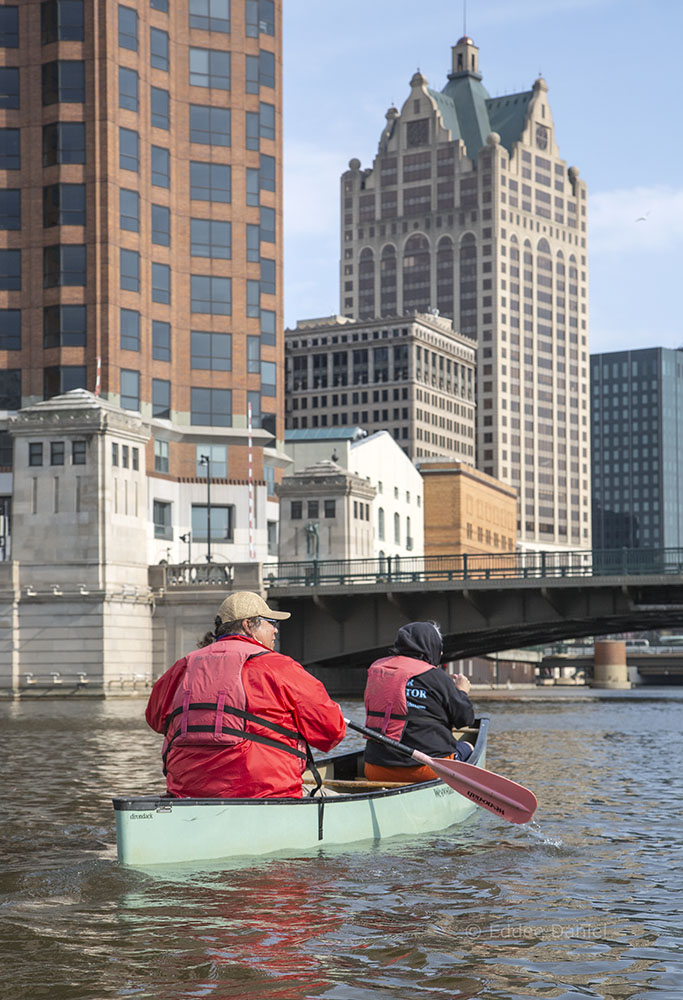
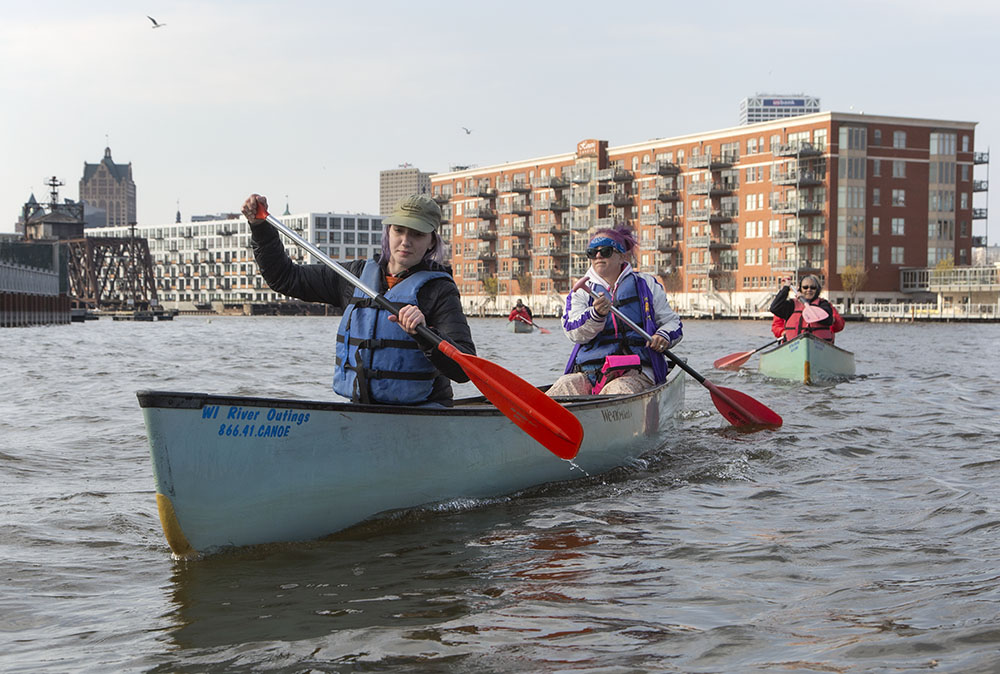

Full Moon Gathering
At the end of a long day, we are back at the lakefront, around another fire. Our circle has grown. Offerings of tobacco and cedar again are placed in the sacred fire, but this time the ceremony is brief, as a prelude to the sharing of stories and reflections from our day on the water. Mark begins, recalling how, just this year, a sturgeon was caught returning to the Milwaukee River—the first since the dam was constructed in 1843. Voices in turn around the circle call out of the flickering darkness. Many extol the surprising natural beauty we witnessed in the Greenway. One of the Water Protectors recounts a Native American story of the creation of Water.
When it is my turn, I express my heartfelt gratitude for being welcomed to join in today’s journey, and share my delight in hearing people in the canoes all around me whoop with joy. It is not a familiar means of expression in my cultural upbringing, I reflect, and such exuberance doesn’t come naturally to me. But it was a memorable treat. I give thanks.

Mark concludes by saying, “The combined group of Menominee River Protectors and Milwaukee Riverkeepers paddled the length of the Milwaukee River Greenway and through downtown Milwaukee, ending at the confluence of the Milwaukee, Kinnickinnic and Menomonee Rivers. This is the first documented effort of its kind in modern times. Like the sturgeon that have continued to inhabit Lake Michigan, Native American people have always been present. But, it’s been over 180 years since the last sturgeon was seen migrating back to the Milwaukee River, and it’s been that long or longer since Menominee people hosted a canoe journey along the river.”
Then, as if on cue, the deep orange disc of the moon begins to show itself above the clouds that obscure the horizon. The congregation turns as one to face the east, watching it rise to fullness. In spontaneous outburst, a chorus of whooping greets Grandmother Moon.
I offer this written account of the day’s proceedings in humility, and with the understanding that for the Indians present the experience was all about the moment, to be remembered in hearts, minds, and spirits.
Mark Denning is descended from Oneida, Menominee, Mille Lacs Band of Ojibwe, Lenape, Delaware, Stockbridge-Munsee Band of Mohican Indian, French, and English ancestors and he is an adjunct lecturer at the University of Wisconsin – Milwaukee.
All images by Eddee Daniel, except as noted. The featured image at the top is by Danielle Kornitz.

